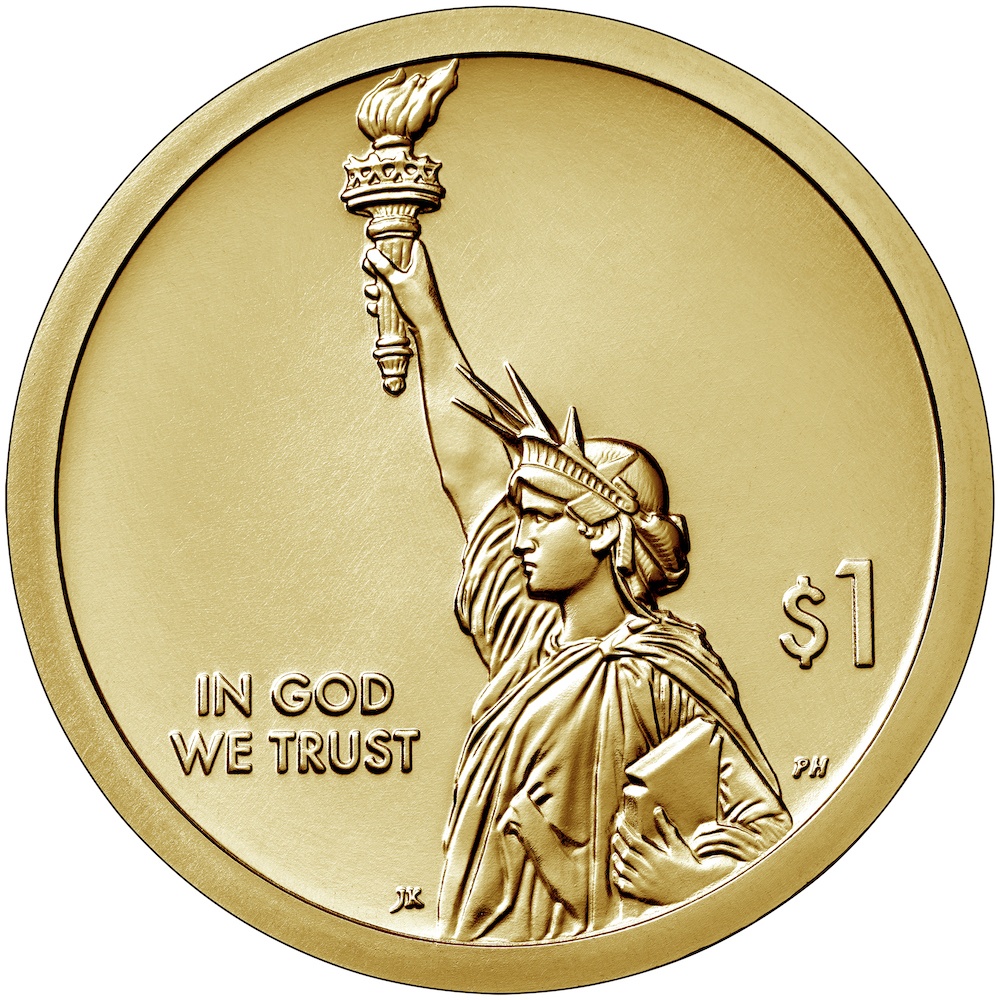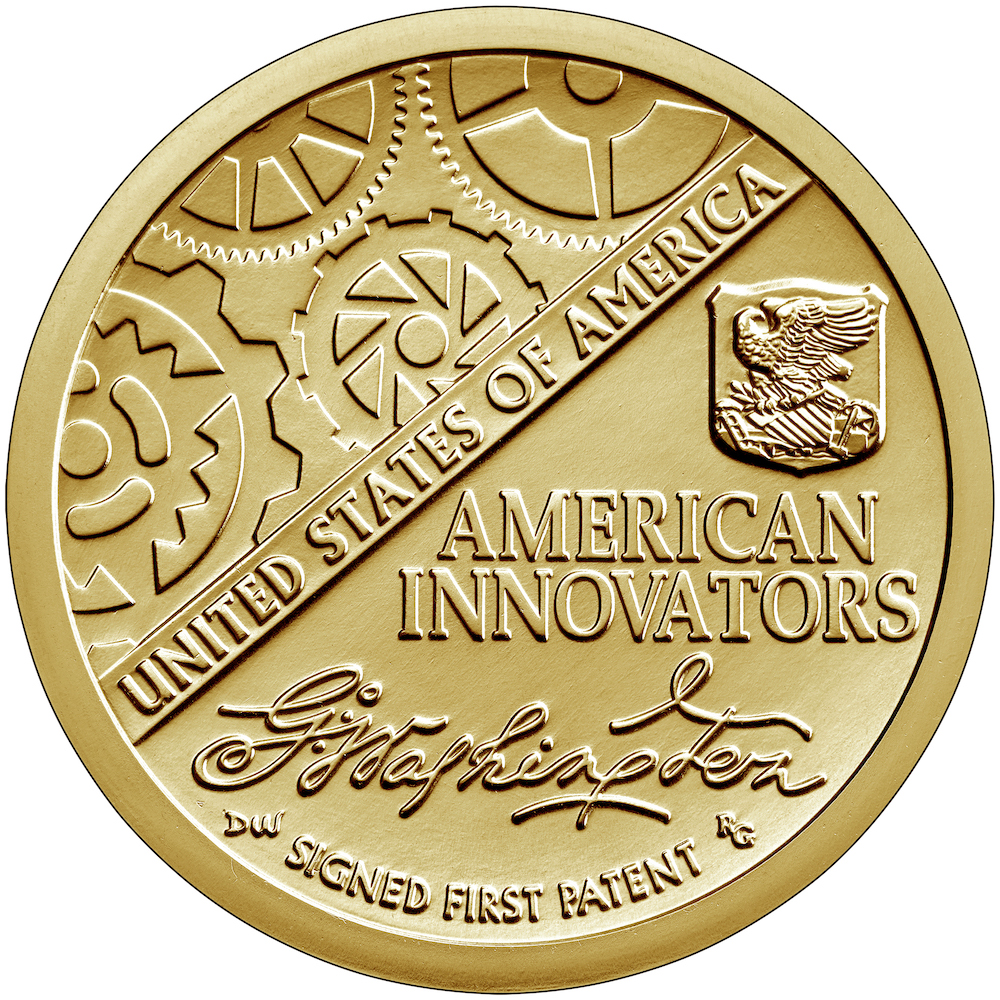Dec 20, 2018 | coin design, coins, dollar, US Mint
 Since U.S. Mint announced the launch of the American Innovation $1 Coin Program there has been nothing but complaints from the community about the coin.
Since U.S. Mint announced the launch of the American Innovation $1 Coin Program there has been nothing but complaints from the community about the coin.
According to the law (Public Law No: 115-97), “The common design on the obverse of each coin issued under this subsection shall contain a likeness of the Statue of Liberty extending to the rim of the coin and large enough to provide a dramatic representation of Liberty.” With the U.S. Mint under a short deadline because of when the bill became law (July 20, 2018), there were a number of disagreements with the Citizens Coinage Advisory Committee regarding the obverse design of the coin. The U.S. Mint tried to modify an old design but the CCAC did not like that. Eventually, the design from Miss Liberty’s left side was used.
It has turned out to be an elegant design that does not duplicate any previous one. She stands on the coin as stately as she stands in New York Harbor, extending from rim to rim as required by law. For once, the CCAC and I agree on a good design.
But that is not enough for some people. The design is too plain.
The reason why the coin appears plain is that two elements that could have been on the obverse, the date and motto “E Pluribus Unum,” are on the edge of the coin.
Edge lettering for the $1 coins began in 2007 with the introduction of the Presidential $1 Program. It was decided to move these elements, along with “In God We Trust” to the edge because the obverse was to include the years of the president’s term. Aside from providing more space for the design, relocating the date would prevent potential confusion as to the date of the coin.
“In God We Trust” was restored to the obverse of the coin in 2009 after striking errors caused the edge of the coin to be blank. This caused overzealous conspiracy theorists and the gullible believing that this was done purposely against the religious communities.
Some argue that since the conditions have changed, the coin should not have edge lettering.
Aesthetically, the obverse design was well executed. It would be how the statue would look if you were standing in Battery Park located at the southern tip of Manhattan, and looked across the water on a clear day. There should be no reason to change the design.
However, there is a problem with the edge lettering in that it makes it difficult to see. As someone who has reached the age where an annual eye exam is a requirement and “corrective lenses” is now a permanent fixture on my driver’s license, having the mintmark on the edge requires me to use magnification to find the mintmark.
As a member of the Baby Boomer generation whose glasses seem to get stronger every year, I would be in favor of moving the date and mintmark to the obverse of the coin. But if the problem is only aesthetics, then I have no problems with having to use a 16x loupe to help identify where the coin was struck.
Dec 16, 2018 | coins, commemorative, dollar, news, US Mint
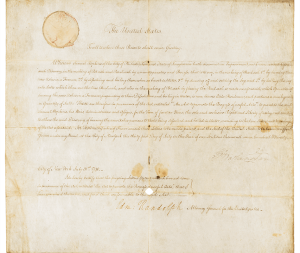
Patent X1 issued to Samuel Hopkins and signed by President George Washington on July 31, 1790 (USPTO Image)
On July 31, 1790, Samuel Hopkins was granted patent number X00001 for this method “in the making of Pot ash and Pearl ash by a new Apparatus and Process.” In June of this year, the U.S. Patent and Trademark Office (USPTO) issued Patent #10,000,000 based on the current numbering system that began in 1836. According to the USPTO, there were 9,433 patents issued from 1790 through 1835.
The other news from the U.S. Mint was the first strike ceremony for the Apollo 11 50th Anniversary Commemorative Coins at the Philadelphia Mint. Children of the three astronauts who flew on Apollo 11 represented their fathers at the ceremony: Mark Armstrong, Andrew Aldrin, and Ann (Collins) Starr.
Coins will be offered for sale to the public on January 24, 2019. The money raised from this commemorative coin program will benefit the Astronauts Memorial Foundation, the Astronaut Scholarship Foundation and the Smithsonian National Air and Space Museum’s “Destination Moon” gallery.

A pair of 5-ounce silver proof $1 coins struck during the First Strike Ceremony at the U.S. Mint (photo courtesy of collectSPACE.com)
And now the news…

December 10, 2018
Cash use has plummeted in Australia over the last few years but Eric Eigner isn't worried. "People will want to collect something that appears to be more scarce," he says. "I think it's a good thing to a certain extent."  → Read more at smh.com.au
→ Read more at smh.com.au

December 10, 2018
The patterns on Guangxi commemorative coins reveal special cultural elements and how the region has developed in the past 60 years.  → Read more at news.cgtn.com
→ Read more at news.cgtn.com

December 10, 2018
Museum intern Roo Weed ’18.5, a physics major, is using digital solutions to make the College’s rare coin collection more accessible to the public.  → Read more at middlebury.edu
→ Read more at middlebury.edu

December 11, 2018
"> <META PROPERTY=  → Read more at miningnewsnorth.com
→ Read more at miningnewsnorth.com

December 14, 2018
From Alexander the Great to the Byzantium and the Middle Ages until the modern era all periods are covered in an exhibition featuring a rare collection of gold coins. This collection contains coins that are considered to have paved the way for the use of coins in world history and is being staged by the …  → Read more at cyprus-mail.com
→ Read more at cyprus-mail.com

December 14, 2018
The United States Mint reveals a new coin collection to commemorate the 50th anniversary of the Apollo 11 moon landing. Item includes great video of striking coins in the mint  → Read more at myhighplains.com
→ Read more at myhighplains.com

December 15, 2018
The U.S. Mint has struck its initial coins commemorating the 50th anniversary of the first moon landing. You could say it was one small strike for the Mint, one not-so-giant press for Apollo history. The coins were stamped as part of a "first strike" ceremony.  → Read more at collectspace.com
→ Read more at collectspace.com

December 15, 2018
The finds are "of great benefit" in helping understand Wales' "unique history", National Museum Wales says.  → Read more at bbc.com
→ Read more at bbc.com
Dec 14, 2018 | coins, dollar, US Mint
Later today, the U.S. Mint will have a ceremony to begin the American Innovation $1 Coin Program. The ceremony is scheduled for 11:30 am at the U.S. Mint’s headquarters at 801 9th Street NW in Washington, D.C.
The American Innovation $1 Coin Program will issue four dollar coins a year in recognition of the significant innovation and pioneering efforts of individuals or groups from each of the 50 States, the District of Columbia, and the United States territories. Coins will be issued in the order that the states entered the union followed by the District of Columbia, Puerto Rico, Guam, American Samoa, the U.S. Virgin Islands, and the Northern Mariana Islands.
As allowed by law (Public Law 115-197), the U.S. Mint is producing an introductory coin for the program that will be presented as part of the launch.
The obverse of the coin, which will be featured throughout the series, is a view of the Statue of Liberty in profile. The view of the upper third of her body with the torch extended to the edge of the coin with a plain background gives the image a quiet elegance that is not usual for a U.S. Mint design. It was designed by Justin Kunz of the Artistic Infusion Program with credit to the Citizens Coinage Advisory Committee for pushing the U.S. Mint to come up with something different.
The reverse design of this introductory coin provides hope that the future of this program will not be mired in trite designs. It honors American Innovation by recognizing the first U.S. patent signed by President George Washington that was issued to Samuel Hopkins on July 31, 1790, for developing a process for making potash. The gears representing innovation appears next to Washington’s autograph.
The year, mint mark, and E PLURIBUS UNUM (Out of many, one) will appear on the edge of the coin as it does with all $1 coins since 2007.
Although it is a fantastic design worthy of a collection that includes the Native American Dollar designs, it will have the same impact as all dollar coins issued in the 21st century. It is a coin that will barely circulate and will not grab the attention of the U.S. public without its circulation.
Even though Congress creates these programs and has been told that this program will be a failure because the coins will not circulate alongside the paper dollar, they continue as if nothing is wrong. Even the Government Accounting Office, their own agency that helps with investigations and oversight of the federal government, has recommended eliminating the one-dollar note.
I will collect these coins as I have done for all of the special series introduced in the 21st century. But I will not be as enthusiastic about this series as I should be until something is done to make these coins circulate.
Aug 2, 2018 | coins, dollar, errors, ethics, scams, US Mint, varieties
This week’s LOOK BACK is my take at the stir made over the positioning of the edge letters on the newly struck George Washington Dollar coins in 2007.
If you search the online auction sites, you will find less than honest sellers trying to sell variations in the positioning of edge lettering of the new George Washington Dollars errors or varieties. Letters that are pointed up, or the top of the letters towards the obverse, are considered “normal” by these sellers. Letters that are pointed downward, or the top of the letters closer to the reverse of the coin, have been called errors or varieties. They are neither.
Exasperating the issue is that one third-party grading service added a designation to their labels with the orientation of the edge lettering.
-
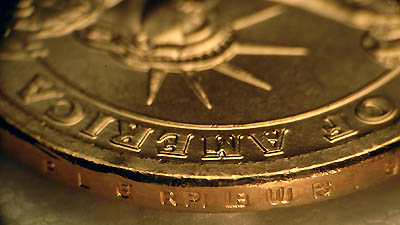
-
According to one third-party grading service, Presidential Dollars With The Tops The
Edge Lettering Facing the Reverse Are Designated As “Position A.”
-
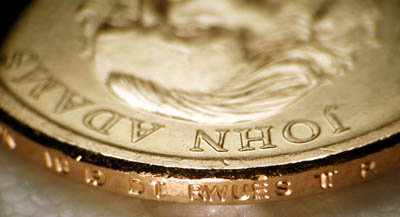
-
Those With The Tops Of Their Letters Facing The Obverse Are “Position B.”
An accepted definition of a variety “is any variation in the normal design of a given coin, usually caused by errors in the preparation or maintenance of the coin dies.” They are also errors caused in the striking process. But these definitions do not account for the differences in the orientation. The problem is that after the planchets are struck into coins by the high-speed coining machines, they are mechanically collected and fed into a machine that will press the lettering into the edge of the coins.
The machine that adds the edge lettering uses a three-part collar to impress the incuse lettering does this without regard to position. not only could the edge lettering face any direction, but the lettering can appear at any position along the edge. The U.S. Mint confirms this by saying that because of “the minting process used on the circulating coins, the edge-incused inscription positions will vary with each coin.”
Since the Mint is saying that the process can vary, these variations are normal for the design. Since these are normal variations, they are not numismatic varieties or errors. Thus, the coins with variations of orientation edge lettering are not worth the premiums being sought online. They are worth their face value of $1.
There have been errors found with the edge lettering. The most infamous has been called the “Godless Dollars” for coins missing their edge lettering and the motto “In God We Trust.” Most of these coins were minted in Philadelphia and discovered in Florida. Others have found doubling of edge letters and what looks like breaks in the three-part collars where letters have moved out of place. These are legitimate errors and worth a premium above face value. Orientation variations of the edge lettering are not errors.
If you want to consider these varieties, please save your money and visit your local bank. You can purchase these coins for face value without shipping and handling fees. If you purchase a 25-coin roll, you can spend the coins you do not want since they are legal tender.
The original article can be read
here.
Jul 24, 2018 | coins, dollar, legislative
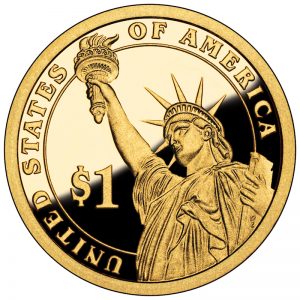 On July 20, 2018, the president signed the American Innovation $1 Coin Act to become Public Law No. 115-197.
On July 20, 2018, the president signed the American Innovation $1 Coin Act to become Public Law No. 115-197.
Beginning in 2019, there will be four dollar coins issued where the obverse will be “a likeness of the Statue of Liberty extending to the rim of the coin and large enough to provide a dramatic representation of Liberty.” The reverse will be emblematic of an innovation, innovator, or a group of innovators significant to that state or territory. The dollar coins will use the same Manganese-Brass composition as all dollar coins struck since 2000 with the edge lettering consisting of the year, mintmark, and the national motto E PLURIBUS UNUM.
The American Innovation $1 Coin will be issued in the same order as the 50 State Quarter Program, the order the states entered the union, followed by the District of Columbia and U.S. Territories.
The order will be as follows:
2019
- Delaware
- Pennsylvania
- New Jersey
- Georgia
2020
- Connecticut
- Massachusetts
- Maryland
- South Carolina
2021
- New Hampshire
- Virginia
- New York
- North Carolina
2022
- Rhode Island
- Vermont
- Kentucky
- Tennessee
2023
- Ohio
- Louisiana
- Indiana
- Mississippi
2024
- Illinois
- Alabama
- Maine
- Missouri
2025
- Arkansas
- Michigan
- Florida
- Texas
2026
- Iowa
- Wisconsin
- California
- Minnesota
2027
- Oregon
- Kansas
- West Virginia
- Nevada
2028
- Nebraska
- Colorado
- North Dakota
- South Dakota
2029
- Montana
- Washington
- Idaho
- Wyoming
2030
- Utah
- Oklahoma
- New Mexico
- Arizona
2031
- Alaska
- Hawaii
- District of Columbia
- The Commonwealth of Puerto Rico
2032
- Guam
- American Samoa
- The U.S. Virgin Islands
- The Northern Mariana Islands
Happy collecting!
Jul 15, 2018 | ANA, coins, dollar, news
With a lot of the international news focused on the finding of ancient coins buried in old ruins, the story that caught my eye came out of Colorado Springs.
Glenna Goodacre, the designer of the Sacagawea Dollar and a graduate of Colorado College in Colorado Springs, donated several items relating to the design of the dollar coin to the American Numismatic Association Money Museum.
Donations include several plaster and bronze casts of the coin that were used to test the design and show the relief of the coin. There is also a plaster cast with an alternate version without her baby, Jean Baptiste Charbonneau, on her back.
News of the donation was published on Friday, July 13, 2018. According to the article, ANA communications coordinator Amanda Miller said that there were no immediate plans to display these items.
Following a significant donation, the ANA will issue a press release. When they do, it would be nice to read that some of these items would be on display at the World’s Fair of Money next month in Philadelphia.
And now the news…

July 9, 2018
An uninhabited island off the coast of Arnhem Land may be the discovery place of a medieval African coin, which, if confirmed, would be among the oldest foreign artefacts ever found in Australia.  → Read more at abc.net.au
→ Read more at abc.net.au

July 12, 2018
The Money Museum, the local, official museum of the American Numismatic Association, recently announced an exciting new donation to its collection. Sculptor and Colorado College graduate Glenna Goodacre has given the museum a selection of items related to the Sacagawea dollar, for which she designed the obverse (the face side).  → Read more at csindy.com
→ Read more at csindy.com

July 13, 2018
The tenacity of amateur archaeologists and historians searching on a remote island off the coast of the Northern Territories in Australia seems to have finally paid off. The team has found a small coin that apparently comes from a medieval African city.  → Read more at ancient-origins.net
→ Read more at ancient-origins.net

July 13, 2018
The banknotes highlight Nelson Mandela’s historical journey, from the rolling hills of the Eastern Cape to the Union Buildings. More than 400 million banknotes and coins bearing the face of South Africa’s first president in the era of democracy, the late Nelson Mandela, are being released to commemorate his centenary.  → Read more at citizen.co.za
→ Read more at citizen.co.za

July 15, 2018
A Virginia Beach coin dealer recently spent $2.64 million on a rare coin from 1834. He and his business partner are collecting coins from 1792 to present day.  → Read more at pilotonline.com
→ Read more at pilotonline.com

July 15, 2018
The Bank of Jamaica (BOJ) has named GraceKennedy Payment Services Ltd (GKPS) as an official coin collection agent in the national coin redemption drive.According to the BOJ, following efforts to identify agents to widen its coin redemption drive, it…  → Read more at jamaica-gleaner.com
→ Read more at jamaica-gleaner.com
Jul 2, 2018 | coins, commemorative, dollar, legislative, US Mint
Sometimes watching specific legislation to make its way through Congress is like watching paint dry. We know the paint will eventually dry but it takes a lot longer than we have time to wait. With the exception of bills that are proposing useful things like eliminating the paper dollar for a coin, there is no point to check daily.
But that is what I do. I wrote a program to download the bill information produced by the Government Printing Office on behalf of the Congress and store it in a database so that it can be reported here. This process does not become interesting until something happens.
The last two weeks in June looks like it was the equivalent of a wild ride. First, the American Innovation $1 Coin Act (H.R. 770) appeared on the agenda in the House of Representatives where the only “debate” was Rep. Jim Himes (D-CT), the bill’s sponsor, and the day’s floor manager, Rep. Sean Duffy (R-OH) speaking in favor of passage. Then it followed the regular course of passage by the House, passage by the Senate with a change, followed by the House agreeing with the amendment. Next month it should be signed into law by the President.
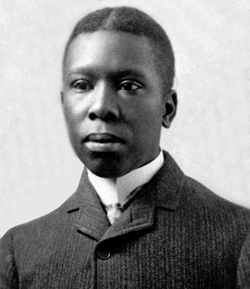
Paul Laurence Dunbar, circa 1890
Paul Laurence Dunbar (1872-1906) was an American poet, novelist, and playwright. Dunbar was very popular in his day whose work was known for its colorful language and conversational tone that made his work seem lyrical. Dunbar, who was born in Dayton, Ohio as a child of former slaves, was famous for writing in the “Negro dialect” that was associated with the antebellum south.
Dunbar had briefly worked at the Library of Congress before resigning to concentrate on his writing. His home in the LeDroit Park neighborhood of Washington, DC still stands today. In 1904 he returned to Dayton to be with his ailing mother but ended up contracting tuberculosis and dying in 1906.

Carson City Mint (1866)
The Carson City Mint opened in 1870 primarily in response to the Comstock Lode. It started as an Assay Office in 1963 but did not gain Mint status until 1870. It was in operation from 1870-1885 and 1889-1893. It is the only branch of the U.S. Mint to have used a two-letter mint mark.
Today, the building is a branch of the Nevada State Museum.
Since the text of both bills has not been published, details of the programs are unknows except it is safe to assume that the Carson City 150th Anniversary commemorative coin program will occur in 2020.
H.R. 770: American Innovation $1 Coin Act
Summary: (Sec. 2) This bill directs the Department of the Treasury, over a 14-year period beginning in 2019, to mint and issue “American Innovation” $1 coins commemorating innovation and innovators from each state, each U.S. territory, and the District of Columbia. Treasury shall issue four coins per year, in alphabetical order by jurisdiction, until a coin has been issued for each jurisdiction. Treasury may mint and issue a $1 coin in 2018 to introduce the series. Neither the bust of any person nor the portrait of any living person may be included in the design of the coins.The bill instructs Interior to continue to mint and issue $1 coins honoring Native Americans and their contributions.
Motion to reconsider laid on the table Agreed to without objection. — Jun 27, 2018
On motion that the House agree to the Senate amendment Agreed to without objection. (text as House agreed to Senate amendment: CR H5786-5787) — Jun 27, 2018
Mr. Hensarling asked unanimous consent to take from the Speaker’s table and agree to the Senate amendment. — Jun 27, 2018
Message on Senate action sent to the House. — Jun 21, 2018
Passed Senate with an amendment by Voice Vote. — Jun 20, 2018
Measure laid before Senate by unanimous consent. — Jun 20, 2018
Senate Committee on Banking, Housing, and Urban Affairs discharged by Unanimous Consent. — Jun 20, 2018
Received in the Senate and Read twice and referred to the Committee on Banking, Housing, and Urban Affairs. — Jan 17, 2018
Motion to reconsider laid on the table Agreed to without objection. — Jan 16, 2018
On motion to suspend the rules and pass the bill, as amended Agreed to by voice vote. — Jan 16, 2018
DEBATE – The House proceeded with forty minutes of debate on H.R. 770. — Jan 16, 2018
Considered under suspension of the rules. — Jan 16, 2018
Mr. Duffy moved to suspend the rules and pass the bill, as amended. — Jan 16, 2018
Referred to the House Committee on Financial Services. — Jan 31, 2017
H.R. 6214: To require the Secretary of the Treasury to mint commemorative coins in recognition of Paul Laurence Dunbar.
Referred to the House Committee on Financial Services. — Jun 25, 2018
H.R. 6221: To require the Secretary of the Treasury to mint coins in commemoration of the Carson City Mint 150th anniversary, and for other purposes.
Referred to the House Committee on Financial Services. — Jun 26, 2018
All images courtesy of Wikimedia Commons.
Jun 28, 2018 | coins, dollar, legislative, US Mint

Presidential $1 Coin Common Reverse
The next step is that the bill is engrossed, which means that it will be printed in its final form and signed by the Speaker of the House, Paul Ryan (R-WI), and the President Pro Tempore of the senate, Orrin Hatch (R-UT), certifying that the printed bill has been approved by both chambers of commerce.
Once signed, the bill is sent to the White House for the President’s signature.
If this bill was not on your radar, it requires the coins use the same Manganese-Brass composition as all dollar coins struck since 2000 with the edge lettering consisting of the year, mintmark, and the national motto E PLURIBUS UNUM. The obverse will be “a likeness of the Statue of Liberty extending to the rim of the coin and large enough to provide a dramatic representation of Liberty.” The reverse will be emblematic of an innovation, innovator, or a group of innovators significant to that state or territory.
If the president signs this bill, and there is no reason why he would veto this biil, then the program will begin in 2019.
Jun 24, 2018 | coins, commentary, dollar, news
On June 20, 1988, the Royal Australian Mint replaced its two dollar currency note with a coin. This year, they are celebrating the coin’s 30th anniversary. It was introduced four years after replacing the dollar paper note with a coin (1984).
Similarly, the Royal Mint introduced the one-pound coin in 1983 and the Bank of England stopped issuing one-pound currency in 1984.
The Royal Canadian Mint introduced the dollar coin, nicknamed the Loonie, in 1987 while the Bank of Canda ceased issuing the paper dollar.
The euro entered began circulating as a continental currency beginning in January 2002. When it was introduced, they issued one- and two-euro coins and the lowest denomination paper currency was the 5 euro note.
According to the International Monetary Fund, after the United States, the European Union has the world’s second largest economy even though it is not ranked as a country. When considering countries, the second largest economy is China followed by Japan, Germany, and the United Kingdom. Canada is the world’s tenth largest economy.
Of the Top Ten, only the United States and China issue their unit currency as paper. However, because of economic controls and exchange rate, most of the Chinese economy is based on the Renminbi (the People’s Money). Small change is popular in urban areas and paper is more common in rural areas.
But the Chinese economy is heavily regulated within the country. Of the Top 20 economies identified by the International Monetary Fund, only the United States and China issues its unit currency as paper notes. Most countries issue a note of two of their base units and many are considering replacing their five unit note with a coin.
Yet the United States, the country with the largest economy on earth, the one that people say should be the leader lags behind every country except China by producing a one dollar paper note.
The lack of paper currency has not hurt these other economies. In fact, it helps because coins last longer than paper currency. Also, it is better for the government because, for every one-dollar coin produced, the government makes 68-cents in seignorage (with the dollar coins costing an estimated 32-cents each to produce).
Replacing paper mone with the coin does not seem to have hurt other economies, yet the issue raises the ire of some who wants to call this a conspiracy against the people. It makes economic sense to move in this direction and should we not be all in favor of doing things in our own economic benefit?
And now the news…

June 19, 2018
The durability of the $2 coin means it could be around for decades to come, despite Australia’s shift towards a cashless society.  → Read more at abc.net.au
→ Read more at abc.net.au

June 20, 2018
Sofia. 34,000 fake coins were found in the home of the main member of a criminal group involved in counterfeit money making and distribution, prosecutor Nikolay Dimitrov said during a briefing.  → Read more at focus-fen.net
→ Read more at focus-fen.net

June 20, 2018
A sterling effort in more ways than one.  → Read more at breakingnews.ie
→ Read more at breakingnews.ie

June 21, 2018
A graduate of Glenwood High School in Chatham designed Illinois’ bicentennial coin, which is available for preorder for $45 on the state treasurer’s website.  → Read more at ilnews.org
→ Read more at ilnews.org

June 21, 2018
Residents in Puerto Rico were left without power for months after Hurricane Maria pummeled Puerto Rico, and experts estimate that around 4,640 people died. But the Environmental Protection Agency thinks it did an A-plus job responding to the disaster.  → Read more at thehill.com
→ Read more at thehill.com

June 23, 2018
On this day in 1775, the Second Continental Congress issued $2 million in bills of credit.  → Read more at politico.com
→ Read more at politico.com

June 23, 2018
The National Bank of Ukraine (NBU) and Crane Currency on June 22 signed the Agreement of Cooperation in the field of currency production, the central bank’s press service reports.  → Read more at ukrinform.net
→ Read more at ukrinform.net

June 24, 2018
Under President Trump, once stately medallions have gotten glitzier, and at least one featured a Trump property. Ethics watchdogs are worried.  → Read more at nytimes.com
→ Read more at nytimes.com
Jun 22, 2018 | coins, dollar, legislative
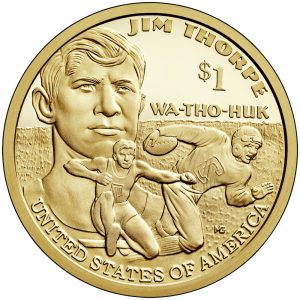
2018 Native American $1 Coin featuring Jim Thorpe
On Wednesday, June 20, the Senate passed the American Innovation $1 Coin Act (H.R. 770) by a unanimous voice vote. However, since the bill was amended by the Senate, the bill has to go back to the House of Representatives to approve the amendment or it will have to go to a conference committee and back to each chamber for a vote.
The amendment changes the order of issuance from alphabetical order to the order that the state entered the union followed by the District of Columbia and the territories. This was the same order uses for the 50 State Quarters program.
If the House approves the amendment, it is sent to the President for his signature.
If signed, the 14-year program will honor “American innovation and significant innovation and pioneering efforts of individuals or groups from each of the 50 States, the District of Columbia, and the United States territories.” Four dollar coins will be issued each year and not circulate alongside the Native American Dollar coin.
The bill requires the coins use the same Manganese-Brass composition as all dollar coins struck since 2000 with the edge lettering consisting of the year, mintmark, and the national motto E PLURIBUS UNUM. The obverse will be “a likeness of the Statue of Liberty extending to the rim of the coin and large enough to provide a dramatic representation of Liberty.” The reverse will be emblematic of an innovation, innovator, or a group of innovators significant to that state or territory.
I wish I could get excited about this series but it will not even raise an eyebrow as long as it does not circulate. And the only way it will circulate is if Congress votes to eliminate the one-dollar Federal Reserve Note. Unfortunately, the likelihood of that happening is slim-to-none and Slim just left town!
 Since U.S. Mint announced the launch of the American Innovation $1 Coin Program there has been nothing but complaints from the community about the coin.
Since U.S. Mint announced the launch of the American Innovation $1 Coin Program there has been nothing but complaints from the community about the coin.

 → Read more at
→ Read more at 